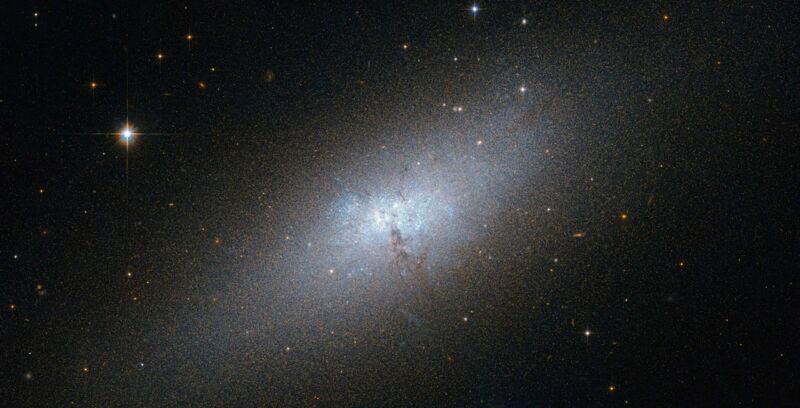It is impossible for a telescope to image and far from being completely understood, yet dark matter is everywhere.
The deepest mysteries about dark matter relate to its nature and behavior. The prevailing idea regarding dark matter is the cold dark matter theory (CDM), which posits that dark matter is made up of low-velocity particles that do not interact with each other. This thinking has been debated—and it is up for debate again. Led by astrophysicist Hai-Bo Yu, a team of researchers from the University of California, Riverside have devised an alternative idea that explains two extremes where cold dark matter doesn't work well.
Galaxies and galaxy clusters are thought to be surrounded by halos of dark matter. At one end of the controversy are galactic dark matter halos that are too dense to be consistent with CDM, and at the other are galactic dark matter halos too diffuse for CDM to make sense of. Yu and his colleagues instead suggest that some dark force (sorry, Star Wars fans—not the Force) causes dark matter particles to smash into each other. This is Self-Interacting Dark Matter (SIDM).
The idea of invisible particles that interact, either pushing each other further away and outwards in a diffuse halo, or pulling each other closer together and inwards in a dense one, may be what we were seeking in the dark. But first, why is dark matter overwhelmingly thought to be cold?
Lost in the dark
Dark matter is “dark” because its interactions with visible matter and electromagnetic radiation are either weak or nonexistent. No light can illuminate it because of its inability to have significant interactions with any kind of electromagnetic radiation. The reason dark matter is said to be “cold,” at least according to the cold dark matter theory, is because the sluggish particles are thought to move much more slowly than the speed of light.
CDM is still the standard model for dark matter because it works for building and maintaining cosmic structures such as galaxies. If dark matter is cold, then it can clump up and aggregate more easily than if it was zooming through the vacuum of space—which it would be if all dark matter was “hot” or made of lighter particles traveling at high velocities. Hot dark matter particles would be too fast to form structures over long periods, and it would flatten any existing structures it ran into. Warm dark matter falls somewhere between cold and hot.
How many kinds of dark matter that exist is unknown. Some scientists insist all dark matter is cold, while others argue that there is more than one type.
While CDM isn’t saying this invisible matter is totally motionless, it does not allow for lots of dark matter particles to collide. This is where SIDM comes in.
Shedding more light
While hot and warm dark matter were beyond the scope of their study, Yu and his team tested whether SIDM could explain one aspect of the cold dark matter that doesn't really work: it struggles to explain extremely dense and extremely diffuse dark matter halos.
“In the [diffuse scenario], interactions transport heat from outer to inner halo regions, lowering the central density; in the [dense scenario], the direction of heat flow reverses and the inner halo becomes denser than its CDM counterpart,” they said in a study recently published in The Astrophysical Journal Letters.
Ultradiffuse galaxies (UDGs) are dwarf galaxies that are especially dim because their stars are scattered far away from each other. Star-forming gas is spread too thin to produce many new stars. An ultradiffuse galaxy’s dark matter halo reaches much further out than that of a regular dwarf galaxy, which shouldn’t happen with the collisionless particles proposed by CDM—particles that do not interact would be closer together and produce a denser halo with a shorter reach. SIDM allows particles to collide and transfer heat, and the expansion of dark matter that results can explain why these halos are so diffuse.
The second scenario deals with dark matter halos so dense they impact gravitational lensing. These dense halos have enough dark matter to bend spacetime so that light traveling through that region of space also bends. Because of these perturbations, an object behind the lensing galaxy is magnified, although often in a somewhat warped way. SIDM also supports dark matter concentrations sufficient for affecting gravitational lensing because colliding particles should be able to go inward just as they go outward. Particles bumping each other closer together increases the halo’s density, and a horde of them can form a massive dark matter blob that produces gravitational lensing.
We are still in the dark about dark matter in many ways. Until there is a way to directly detect it, we have to rely on theoretical work to figure out whether ideas like SIDM could be onto something. Maybe someday, we'll have a method of direct detection that will finally bring the mysteries of dark matter to light.
Astrophysical Journal Letters, 2023. DOI: 10.3847/2041-8213/ad0e09



3175x175(CURRENT).thumb.jpg.b05acc060982b36f5891ba728e6d953c.jpg)
Recommended Comments
There are no comments to display.
Join the conversation
You can post now and register later. If you have an account, sign in now to post with your account.
Note: Your post will require moderator approval before it will be visible.